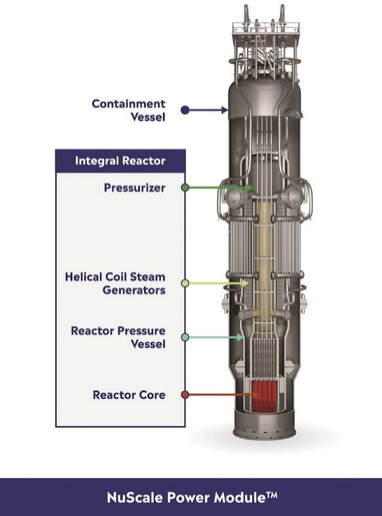SUBJECT TO COMPLETION, DATED May 12, 2022
PRELIMINARY PROSPECTUS
228,011,646 Shares of Class A Common Stock
8,900,000 Warrants to Purchase Shares of Class A Common Stock
NUSCALE POWER CORPORATION
This prospectus relates to (1) the issuance by us of up to 178,396,711 shares (“Exchange Shares”) of Class A Common Stock, par value $0.0001 per share (“Class A Common Stock”), of NuScale Power Corporation, a Delaware corporation (“NuScale Corp,” “we,” “our” or “us”), upon exchange (on a one-for-one basis, subject to adjustment) of Class B Units of NuScale Power, LLC, an Oregon limited liability company (“NuScale LLC”) and cancellation of a corresponding number of shares of Class B Common Stock, par value $0.0001 per share, of NuScale Corp, and the resale of 171,755,372 Exchange Shares, the resale of which might otherwise be limited by the resale restrictions imposed on “control securities” under Rule 144 under the Securities Act; (2) the issuance by us of up to 11,500,000 shares of Class A Common Stock upon the exercise of the NuScale Corp Public Warrants (as defined below); (3) the issuance by us of up to 8,900,000 shares of Class A Common Stock upon the exercise of NuScale Corp Private Placement Warrants (defined below) and the resale of such shares; and (4) the resale from time to time by the selling securityholders named in this prospectus or their permitted transferees of up to: 8,900,000 NuScale Corp Private Placement Warrants (as defined below) to purchase Class A Common Stock; 23,700,002 shares of Class A Common Stock, which were issued in private placements to PIPE Investors (defined below) immediately prior to the consummation of the Merger (defined below) pursuant to the terms of the Subscription Agreements (defined below); and 5,514,933 shares of Class A Common Stock held by Spring Valley Acquisition Sponsor Sub, LLC and its affiliates and the former officers and directors of Spring Valley Acquisition Corp (“Spring Valley Founders”).
On May 2, 2022 (the “Closing Date”), Spring Valley Acquisition Corp., formerly a blank check company incorporated as a Cayman Islands exempted company (“Spring Valley”), completed the previously announced transactions pursuant to the Agreement and Plan of Merger dated December 13, 2021 (as amended) between Spring Valley, Spring Valley Merger Sub, LLC, an Oregon limited liability company (“Merger Sub”) and NuScale LLC, including: (a) the domestication of Spring Valley as a Delaware corporation (the “Domestication”) and the change of its name to “NuScale Power Corporation”; and (b) the merger (“Merger”) of Merger Sub with and into NuScale LLC, with NuScale LLC as the surviving business entity in the Merger, through which the combined company was reorganized in an “UP-C” structure, with NuScale Corp now serving as the sole manager of NuScale LLC. NuScale LLC is now owned in part, indirectly through NuScale Corp, by former public and private shareholders of Spring Valley and in part directly by continuing equity owners of NuScale LLC (the “Legacy NuScale Equityholders”).
After the Domestication and immediately before completion of the Merger, Spring Valley issued to certain selling securityholders, in private placements, 23,700,002 shares of Class A Common Stock at approximately $10.00 per share, for an aggregate purchase price of $235,000,000.
The selling securityholders may offer, sell or distribute all or a portion of the NuScale Corp Private Placement Warrants and the shares of Class A Common Stock registered hereby publicly or through private transactions at prevailing market prices or at negotiated prices.
We provide more information about how the selling securityholders may sell their shares in the section entitled “Plan of Distribution.”
We will pay certain offering fees and expenses and fees in connection with the registration of the warrants and the Class A Common Stock and will not receive proceeds from the exchange of NuScale LLC Class B Units (and cancellation of a corresponding number of shares of Class B Common Stock) for Class A Common Stock or from the sale of the warrants or shares of Class A Common Stock by the selling securityholders. The selling securityholders will bear all commissions and discounts, if any, attributable to their respective sales of the warrants or the Class A Common Stock.
Our Class A Common Stock is listed on the New York Stock Exchange (“NYSE”) and trades under the symbol “SMR.” On May 11, 2022, the closing sale price of our Class A Common Stock was $10.19 per share. Our public warrants are listed on the NYSE and trade under the symbol “SMR WS.” On May 11, 2022, the closing sale price of our public warrants was $2.35 per warrant.
We are an “emerging growth company” as defined under applicable federal securities laws, and therefore are subject to certain reduced public company reporting requirements.
INVESTING IN OUR SECURITIES INVOLVES RISKS THAT ARE DESCRIBED IN THE “RISK FACTORS” SECTION BEGINNING ON PAGE 9 OF THIS PROSPECTUS.
Neither the Securities and Exchange Commission nor any state securities commission has approved or disapproved of the securities to be issued under this prospectus or determined if this prospectus is truthful or complete. Any representation to the contrary is a criminal offense.
The date of this prospectus is , 2022.



